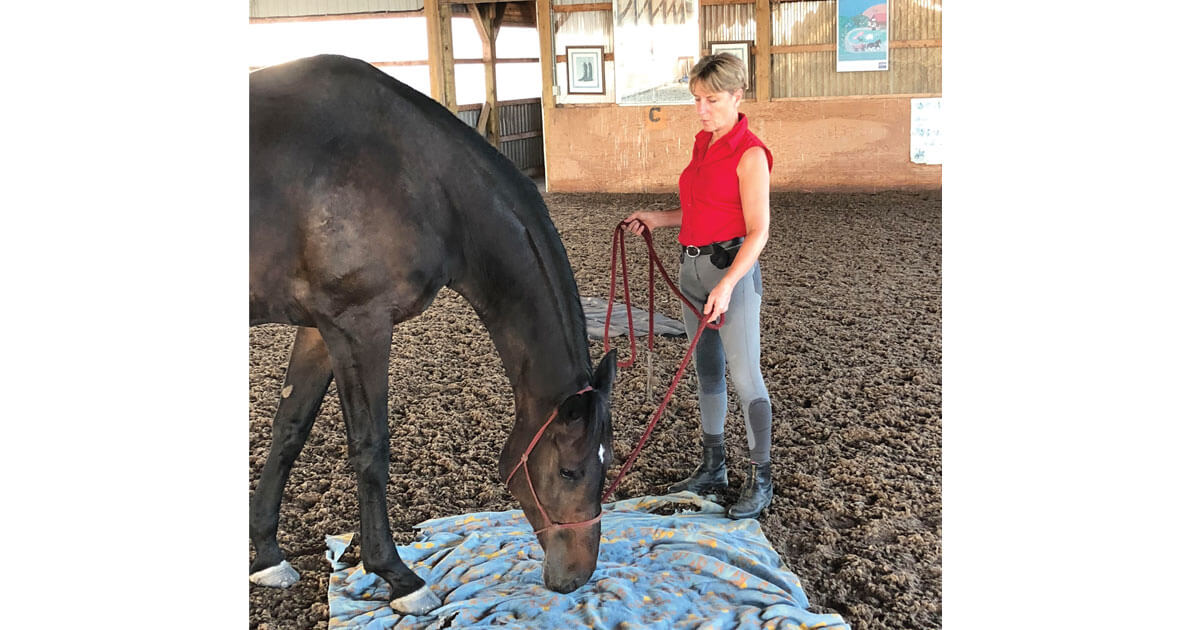When the snow blows and you’re stuck inside, try some of these creative ways to build skills, strength and confidence.
Confidence Building Games for Horses
Add a little fun to your horse’s routine while playing with a purpose. The horse can be on a lunge line or long lead rope. You can also increase the challenge and try the games at liberty, using targeting or positive reinforcement training.
• Barrels – Ask your horse to walk between two barrels, pushing them closer together as his confidence grows. This can help with situations such as loading on a trailer.
• Tarps – Ask the horse to place the nose on, neck over, and then feet on the tarp. Increase the difficulty by having him walk across, then trot and canter over the tarp in both directions.
• Traffic cones – Set up a line of pylons to weave around. This exercise encourages your horse to focus more on you and to become very attuned to your slightest aid to move away or towards an obstacle.
• Dollar store stuff – Crushed plastic water bottles, pool noodles, balloons, and flags can all be used to encourage the horse to be more inquisitive, confident, and relaxed. Have the horse touch them, stand on them, walk over them, and allow you to rub the objects on his body.
Pole Challenges for Horses
To add variety and challenge to your lungeing routine, try incorporating ground poles and raised cavalletti. Start with a basic line of poles on the ground following the arc of your lungeing circle. The ends of the poles nearest you will be closer together, while the outside ends are farther apart. Simply adjust the size of your lungeing circle to ask the horse to lengthen or shorten his stride. Once horse is comfortable, increase the challenge by replacing a pole with a cavalletti, and eventually increasing the cavalletti height. Changing the distance between poles will encourage the horse to lengthen and shorten his stride, a wonderful gymnastic exercise to improve strength and encourage the horse to think about where his feet are.

Long-lining is an effective way to fine-tune steering aids and half-halts – especially with young horses – and can also be used with older animals to navigate items such as a tarp or puddles on the ground, or that scary corner of the arena. (Shelley Higgins photo)
Long-Lining Lessons for Horses
Even the simplest groundwork is valuable in building the connection between horse and rider while saving the horse from always weight bearing. Using long-lining can reinforce or fine-tune things like steering aids and half-halts. You can use it to spook-proof a horse by long-lining over tarps or past ‘scary’ objects. Great for a horse that is a bit arena sour or is recovering from injury.

Challenge your riding buddies to a test of bareback skills (and help pay your board wink wink) by tucking some cash under your thigh while you all walk, trot, canter and even jump!
Mock Horse Shows
The social aspect of going to the barn can suffer in the winter when people tend to ride less, so staging mock competitions can serve two purposes – reconnecting with other riders and giving you a training goal with your horse. They can either be straight-up friendly jumping or dressage competitions, or fun activities like obstacle courses, bareback equitation (see who can keep a $5 bill tucked under their thigh – winner takes all!) or even activities completely outside your wheelhouse like barrel racing or some of the Pony Club Prince Phillip Games. (canadianponyclub.org)

Free jumping allows the horse to use its body without rider influence or interference and can be a great confidence-builder. You may even find your horse heading for the chute without being asked! (Ian Woodley photo)
Free-Jumping Fun for Horses
Free jumping allows you to learn a lot about your horse’s natural jumping style and ability without any hindrance from a rider, which can in turn help you ride him better. For example, if your horse drops his head on takeoff and/or landing or raises it on the approach to the fence, it may just be his way of going and you should learn to work with it, rather than fighting it or trying to correct it. It can also help relax a horse who rushes the fences, work as an introduction to jumping for youngsters, or change up the routine for dressage horses.
Set up a straight “chute” along one side of the arena by resting poles on barrels or jump standards or running a line of high-visibility tape at about chest level. Keep it simple; start with a cross-rail one-stride in-and-out and gradually work up, changing the second fence to a vertical and eventually an oxer. Keep sessions very short; going through the chute 8-10 times over the course of 10-15 minutes is plenty, broken up with many brief mental and physical “breathers.” End each session on a confident note.


